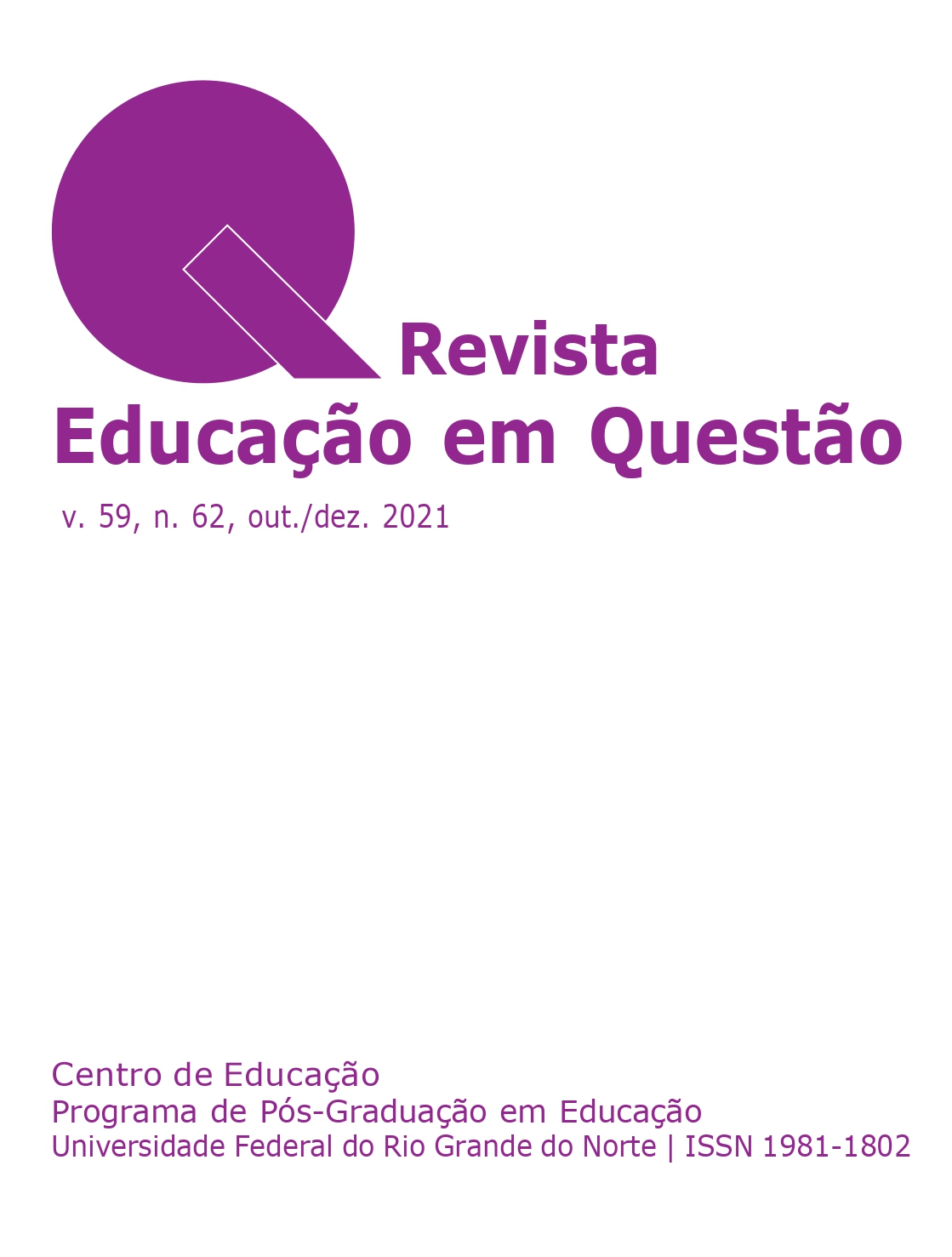Curiosity and imagination in childhood
about the animated film "Scooby doo and the witch's ghost"
DOI:
https://doi.org/10.21680/1981-1802.2021v59n62ID27055Keywords:
Curiosity, Animated movie, Scooby-Doo, School EducationAbstract
Curiosity is a faculty we experience during our childhood and young adult Years. It drives us to look for clues and to ask questions in order to figure out new phenomena. In this article, we discuss curiosity as a human faculty which surfaces energetically during childhood and, based on the analysis of the movie Scooby Doo! And the Witch’s Ghost, we present the definition of curiosity as a “mystery machine” which leads us to ask questions in search of solutions for things which represent the unknown. We understand that curiosity is constituted as a powerful learning tool, given that it is something that walks alongside scientific practice. We approach the theoretical guidance of Edgar Morin and Paulo Freire as we analyze, in the aforementioned movie, how curiosity structures itself between relations of action, astonishment, questioning and answering, based on the dialogues between the characters. The exercise of this faculty, in the context of the movie we chose, may provide a glimpse of learning possibilities which are necessary for na education focused on scientific curiosity in the early school years.
Downloads
References
ALMEIDA, Maria da Conceição de. Complexidade, saberes científicos, saberes da tradição. 2. ed. rev. e ampl. São Paulo: Editora Livraria da Física, 2017.
COSTA, Jardi. Películas clave del cine de animación. Barcelona: Ediciones Robinbook, 2010.
FREIRE, Paulo. Pedagogia da autonomia: saberes necessários à prática educativa. 67. ed. São Paulo: Paz e Terra, 2021.
FREIRE, Paulo; FAUNDEZ, Antonio. Por uma Pedagogia da Pergunta. 7. ed. rev., ampl. e atual. São Paulo: Paz e Terra, 2011.
GROEBEL, Jo. Acesso à mídia e uso da mídia entre as crianças de 12 anos no mundo. In: CARLSSON, Ulla; FEILITZEN, Cecilia Von (org.). A criança e a mídia. Imagem, educação, participação. Tradução Dinah de Abreu Azevedo e Maria Elizabeth Santo Matar. São Paulo: Cortez; Brasília, DF: UNESCO, 2002.
GUIMARÃES, Leandro Belinaso; FATIN, Mônica. O cinema e os filmes de animação em contextos formativos. Educação em Foco, Juiz de Fora, v. 21, n. 1, p. 141-156, mar./jun. 2016. Disponível em: https://periodicos.ufjf.br/index.php/edufoco/article/view/19660. Acesso em: 06 out. 2021.
MACHADO, Camila Juraszeck; SILVEIRA, Rosemari Monteiro Castilho Foggiatto. Interfaces entre cinema, ciência e ensino: uma revisão sistemática de literatura. Pro-Posições, Campinas, v. 31, p. 1-31, jan./dez. 2020. Disponível em: https://doi.org/10.1590/1980-6248-2017-0190. Acesso em: 6 out. 2021.
MANGUEL, Alberto. Uma história natural da curiosidade. Tradução Paulo Geiger. São Paulo: Companhia das Letras, 2016.
MELO, Marcos Gervânio de Azevedo; NEVES, Marcos Cesar Danhoni; SILVA, Sani de Carvalho Rutz da. Alfabetização científico-tecnológica no filme Wall-e: desvelando observações no ensino de ciências. Revista de Didácticas Específicas, n. 18, p. 88-100, jan./jun. 2018. Disponível em: https://revistas.uam.es/didacticasespecificas/article/view/8989. Acesso em: 6 out. 2021.
MORIN, Edgar. Os sete saberes necessários à educação do futuro. 2. ed. Tradução Catarina Eleonora F. da Silva e Jeanne Sawaya. São Paulo: Cortez; Brasília, DF: UNESCO, 2000.
MORIN, Edgar. A cabeça bem-feita: repensar a reforma, reformar o pensamento. 8. ed. Tradução Eloá Jacobina. Rio de Janeiro: Bertrand Brasil, 2003.
MORIN, Edgar. O cinema ou o homem imaginário: ensaio de antropologia sociológica. Tradução Luciano Loprete. São Paulo: É Realizações, 2014.
MORIN, Edgar. O método 3: o conhecimento do conhecimento. 5. ed. Tradução Juremir Machado da Silva. Porto Alegre: Sulina, 2015.
MORIN, Edgar. Conhecimento, ignorância, mistério. Tradução Clóvis Marques. Rio de Janeiro: Bertrand Brasil, 2020.
PEROZA, Juliano; RESENDE, Marilúcia A. Paulo Freire e a dialética da curiosidade: pistas para uma praxiologia do conhecimento. EccoS – Revista Científica, São Paulo, n. 25, p. 77-94, jan./jun. 2011. Disponível em: https://www.redalyc.org/articulo.oa?id=71521708005. Acesso em: 6 out. 2021.
PIASSI, Luís Paulo de Carvalho. Interfaces didáticas entre cinema e ciência: um estudo a partir de 2001: uma odisseia no espaço. São Paulo: Editora Livraria da Física, 2013.
SANTOS, José Nunes dos; GEBARA, Maria José Fontana. Análise pedagógica de filmes: gênero de animação no ensino de ciências. Colloquium Humanarum, [S. l.], v. 12, n. 2, p. 34–41, abr./jun. 2015. Disponível em: https://journal.unoeste.br/index.php/ch/article/view/1238. Acesso em: 6 out. 2021.
SCOOBY-DOO e o fantasma da bruxa. Direção: Jim Stenstrum. Produção de Cos Anzilotti. Estados Unidos: Warner Home Video, 2001. Vídeo. 1 Disco. (67 min), son., color.
TOMAZI, Aline Luiza; PEREIRA, Aline Julyê; SCHÜLER, Cristiane Müller; PISKE, Karin; TOMIO, Daniela. O que é e quem faz ciência? Imagens sobre a atividade científica divulgadas em filmes de animação infantil. Ensaio Pesquisa em Educação em Ciências, Belo Horizonte, vol. 11, n. 2, p. 335-353, jul./dez. 2009. Disponível em: https://doi.org/10.1590/1983-21172009110209. Acesso em: 06 out. 2021.
Downloads
Published
How to Cite
Issue
Section
License
The Journal Education in Question shall retain the copyright in all articles that it publishes.
The authors and co-authors of articles and book reviews, published in the Journal Education in Question, shall wait for at least 1 (one) year before they are allowed to submit new works for publication.






